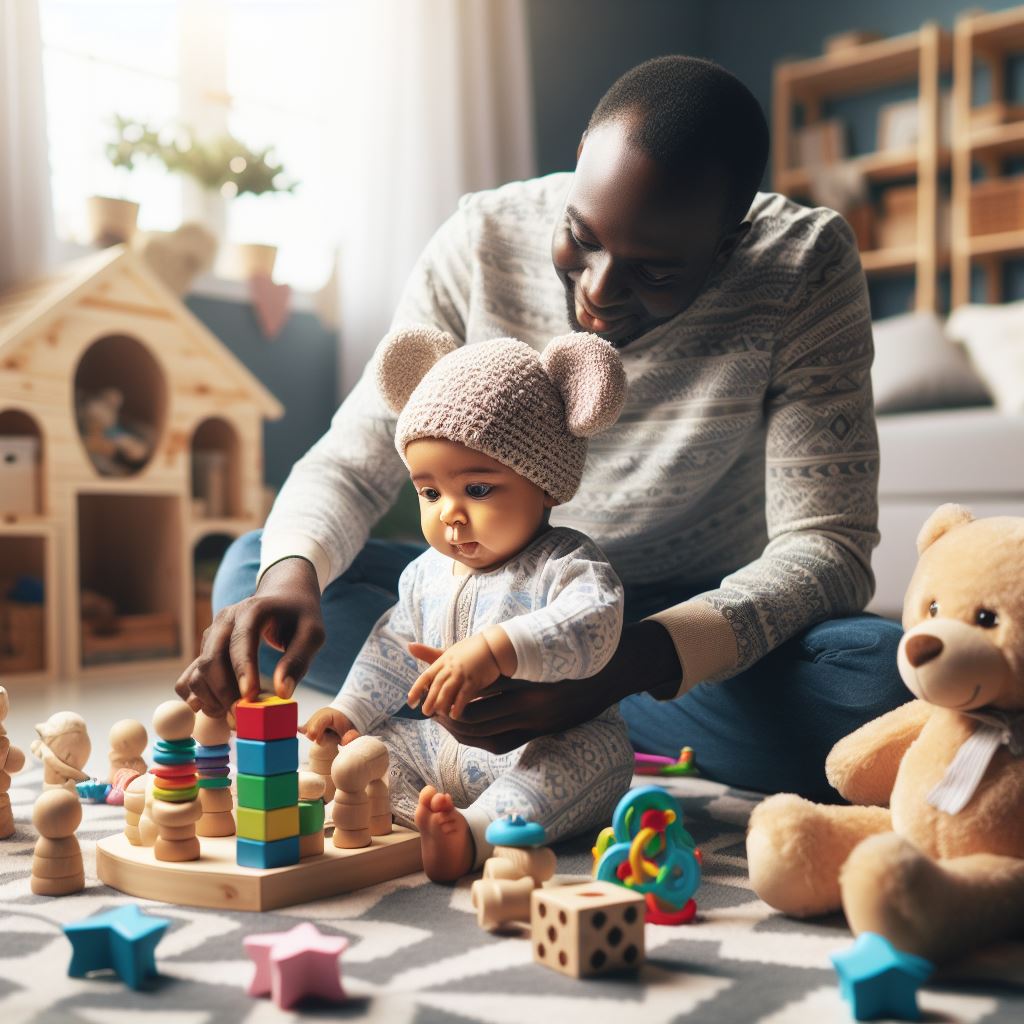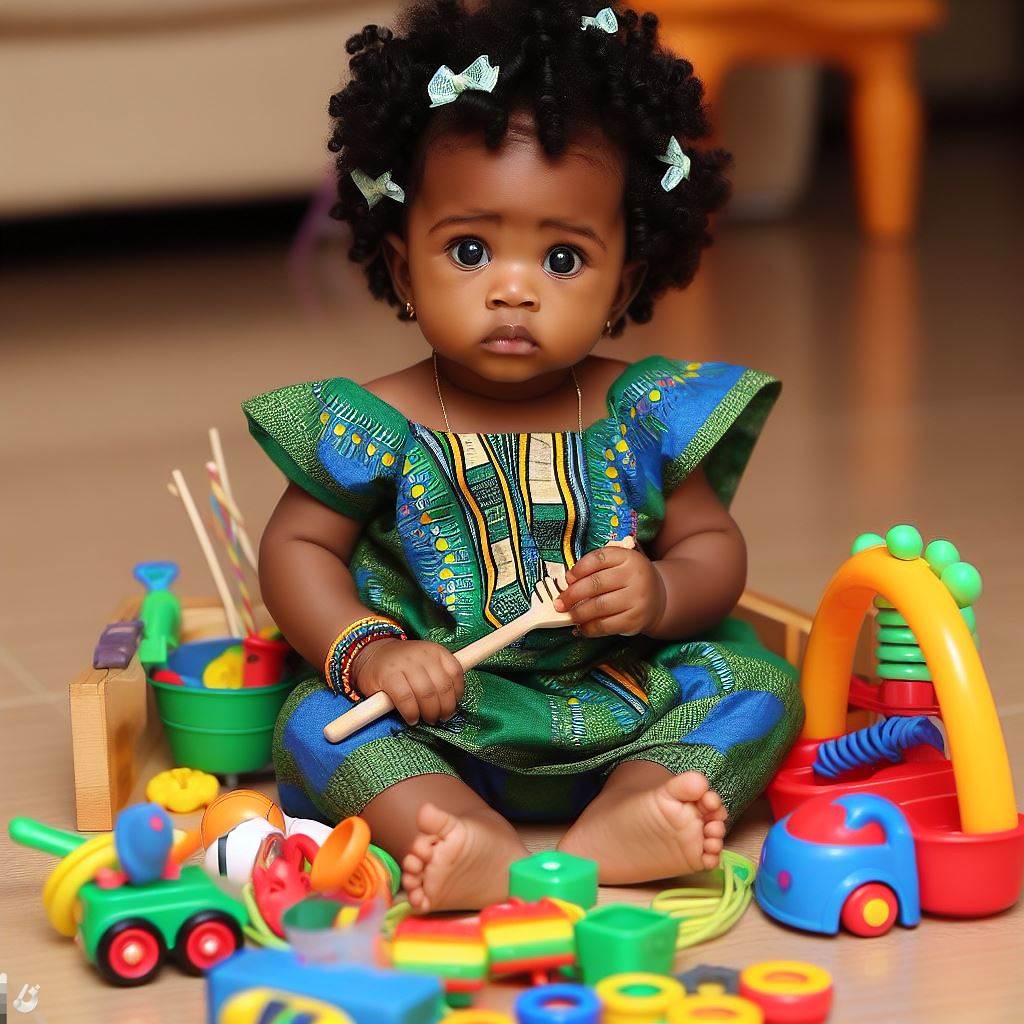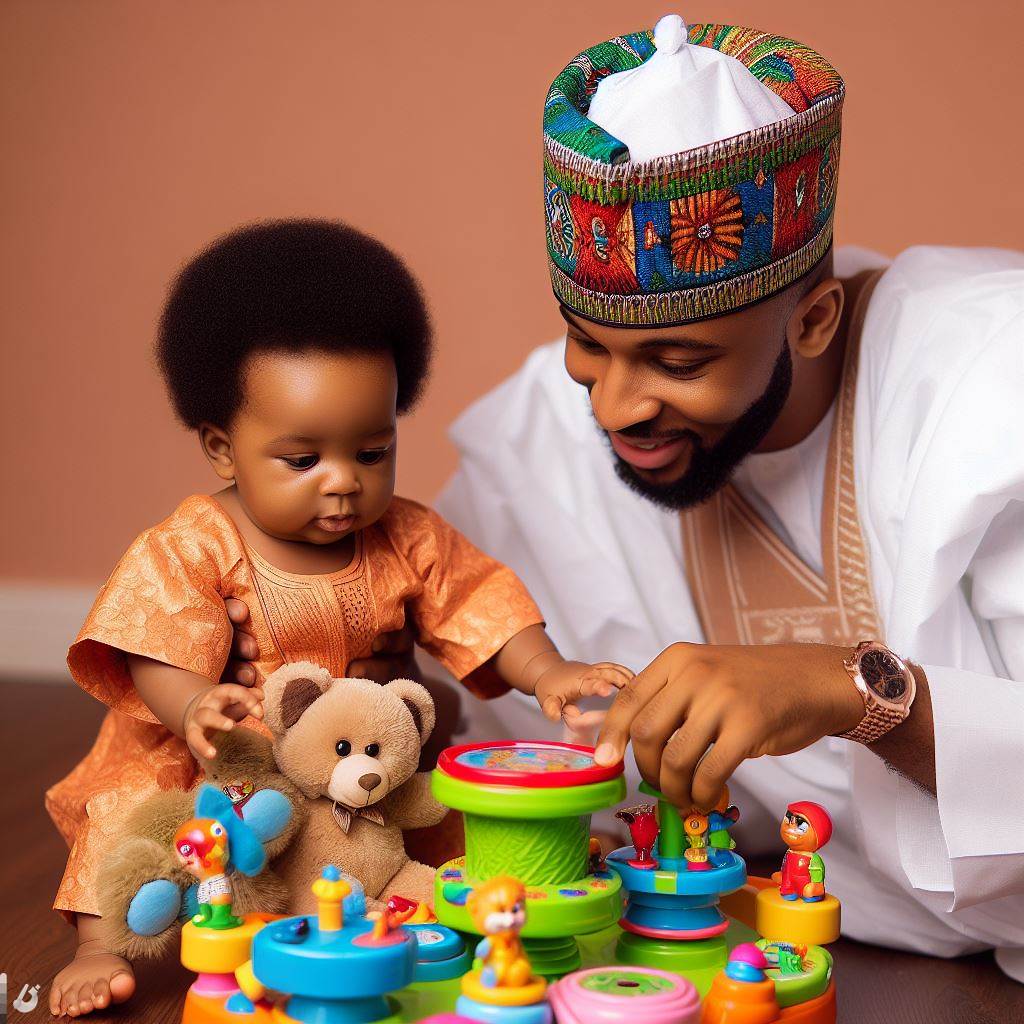Introduction
Creating an environment that stimulates babies’ senses and encourages their growth and development is crucial.
Babies are naturally curious and constantly learning about the world around them.
Therefore, providing them with a stimulating home environment is essential for their overall well-being and development.
In this blog post, we will explore the different aspects of creating a stimulating home environment for babies.
We will discuss the importance of visual stimulation, such as using bright colors and engaging mobiles, to help develop their visual skills.
We will also delve into the significance of auditory stimulation, such as playing soothing music or reading aloud, which can enhance their language skills and cognitive development.
Furthermore, we will highlight the role of tactile stimulation, including providing age-appropriate toys and encourage physical exploration, aiding in fine motor skills and sensory development.
Moreover, we will discuss the importance of creating a safe and nurturing space that promotes emotional and social development.
This includes establishing a routine, displaying affection, and ensuring a calm and secure environment.
Lastly, we will provide practical tips and suggestions on how to incorporate stimulating activities into your baby’s daily routine, ensuring their curiosity and creativity thrive.
By creating a stimulating home environment for babies, we can enhance their overall development, foster their curiosity, and lay the foundation for a healthy and fulfilling life.
So, let’s dive in and explore the world of creating a stimulating home environment for our little ones!
Understanding the Developmental Needs of Babies
Welcoming a baby into your home is a joyous occasion, and as parents, it’s crucial to create an environment that fosters their holistic development.
Babies undergo rapid growth and development in various areas, including cognitive, motor, sensory, and social-emotional.
Recognizing and addressing these developmental needs early on lays the foundation for a healthy and thriving future.
Parenting Made Just for You
Get personalized Parenting Solutions tailored to your child’s needs. Transform your parenting journey with expert guidance in 1-3 days.
Get StartedA. Key Developmental Areas for Babies
- Cognitive Development: Babies are like sponges, absorbing information from their surroundings. Simple activities like reading aloud, introducing contrasting colors, and playing gentle music can stimulate their cognitive abilities.
- Motor Development: From the first grasps of tiny fingers to the first steps, motor development is a significant milestone. Provide age-appropriate toys that encourage reaching, grasping, and eventually crawling or walking.
- Sensory Development: Babies explore the world through their senses. Soft textures, interesting shapes, and varied sounds enhance sensory experiences. Consider a mobile above the crib or a playmat with different textures.
- Social-Emotional Development: Building a secure attachment with caregivers is vital for a baby’s emotional well-being. Respond promptly to their needs, engage in eye contact, and engage in interactive play to promote social and emotional connections.
B. The Critical Role of Early Experiences in Brain Development
The early years are a crucial period for brain development, with the majority of neural connections forming during this time.
Positive experiences and interactions contribute to the creation of a strong neural foundation.
Engage in activities that encourage curiosity, problem-solving, and exploration to stimulate neural pathways.
C. The Importance of Creating a Stimulating Environment
A stimulating environment doesn’t necessarily mean cluttered or overwhelming.
It means providing a variety of age-appropriate stimuli that cater to each developmental area.
Rotate toys regularly, create a cozy reading nook, and establish routines that offer predictability, which is comforting for babies.
In short, understanding and addressing the developmental needs of babies is fundamental to creating a stimulating home environment.
By fostering cognitive, motor, sensory, and social-emotional development, parents play a pivotal role in shaping the foundation for their child’s future.
Embrace the joy of watching your baby grow and learn in a nurturing and enriching space.
Creating a Safe and Enriched Physical Space
As your little one begins to explore the world around them, creating a safe and stimulating home environment becomes crucial for their development.
Here, we’ll delve into the essential aspects of ensuring your baby’s surroundings foster curiosity, growth, and safety.
A. Tips for Baby-Proofing the Home
Safety is paramount. Start by securing furniture to the walls to prevent tipping, covering electrical outlets, and installing safety gates at staircases.
Lock away hazardous items such as cleaning supplies and sharp objects.
Invest in soft corner protectors to cushion sharp edges, and use door stoppers to prevent little fingers from getting caught.
Unveil the Perfect Name that Tells Your Family's Story
Let us help you find a name that embodies your family's values, traditions, and dreams. Our personalized consultation weaves cultural insights to create a name that's uniquely yours.
Get StartedRegularly reassess the baby-proofing measures as your child grows and becomes more mobile.
B. Suggestions for Age-Appropriate Toys and Play Areas
Selecting toys that align with your baby’s developmental stage is crucial.
For infants, high-contrast toys aid visual development, while soft, textured items stimulate tactile senses.
As they grow, introduce toys that encourage grasping, shaking, and exploration.
Create dedicated play areas with soft, washable mats where your baby can safely explore their toys and practice rolling, crawling, and eventually walking.
C. Incorporating Stimulating Visual Elements (Colors, Shapes, Pictures)
Infuse your home with a palette of vibrant colors and simple, contrasting patterns.
Hang visually stimulating mobiles above the crib and place age-appropriate wall art within their line of sight.
Use soft, primary colors in bedding and décor to create a visually engaging atmosphere that captivates your baby’s developing eyesight.
D. Variety of Textures for Tactile Exploration
Texture plays a vital role in sensory development. Introduce a range of textures through soft blankets, plush toys, and textured play mats.
Allow your baby to feel different surfaces under their tiny fingers, promoting sensory exploration and fine motor skills development.
E. Ensuring Adequate Space for Crawling, Walking, and Playing
Allocate ample space for your baby to move freely.
Clear pathways for crawling and designate play areas where they can practice standing and taking their first steps.
Arrange furniture to create a safe and open environment that encourages exploration and independence.
By implementing these tips, you’ll not only create a secure space for your little one but also lay the foundation for a stimulating home environment that promotes healthy development.
Read: Healthy Sleep Patterns for Nigerian Babies
Engaging in Meaningful Interactions and Activities
Creating a stimulating home environment for babies goes beyond providing a cozy crib and cute toys.
Meaningful interactions and purposeful activities are key to fostering a baby’s development.
In this section, we’ll explore the various ways parents can engage with their little ones to promote healthy cognitive, emotional, and physical growth.
A. Benefits of Responsive Caregiving and Bonding
Responsive caregiving is the cornerstone of a strong parent-child bond.
Babies thrive when they feel secure and loved. Respond promptly to their cues, whether it’s a cry for attention or a gurgle of happiness.
This creates a foundation of trust that is vital for their emotional well-being.
B. Encouragement for Verbal and Nonverbal Communication with the Baby
Even before they utter their first words, babies are absorbing language.
Engage in simple conversations, using a soothing tone to create a positive association with communication.
Respond to their coos and babbling, reinforcing the importance of dialogue.
Nonverbal cues, like smiling and maintaining eye contact, also contribute to building a strong connection.
C. Singing, Reading, and Narrating to Promote Language and Cognitive Development
Introduce your baby to the world of words through singing, reading, and narrating daily activities.
Choose age-appropriate books with colorful images and rhythmic patterns.
The cadence of your voice and the varied sounds of language stimulate cognitive development, laying the foundation for future language skills.
D. Incorporating Playtime Activities that Stimulate Motor Skills
Playtime isn’t just fun—it’s a crucial component of a baby’s physical development.
Provide toys that encourage reaching, grasping, and crawling. Tummy time is essential for building strength and coordination.
As your baby grows, introduce activities that promote standing, cruising, and eventually walking.
E. Sensory Activities to Engage All Senses
Babies learn about the world through their senses.
Create sensory-rich experiences by exposing them to different textures, sounds, and smells.
Play with soft fabrics, introduce gentle music, and let them explore safe objects with their mouths.
Sensory activities enhance their cognitive development and create a foundation for future learning.
In essence, fostering a stimulating home environment involves more than just creating a visually appealing space.
Meaningful interactions and purposeful activities contribute to a baby’s holistic development, setting the stage for a lifetime of curiosity and learning.
Read: Nigerian Baby Language Development Tips

Creating a Routine and Structure
A stimulating home environment plays a crucial role in promoting the healthy development of babies.
Creating a routine and structure is essential to provide them with a sense of security and stability.
A. Establishing regular sleep, feeding, and playtime schedules
A. Establishing regular sleep, feeding, and playtime schedules helps babies develop a predictable daily routine.
It ensures they get the necessary rest, nutrition, and playtime for their optimal growth and development.
Having consistent bedtime and waking up times helps regulate the baby’s internal clock, which aids in better sleep patterns.
It also allows parents to plan their day accordingly, creating a balance between caring for the baby and other responsibilities.
Similarly, regular feeding schedules not only fulfill the baby’s nutritional needs but also provide a sense of security and comfort.
Having set meal times prevents the baby from feeling hungry or deprived, fostering a content and trusting relationship with food.
Playtime schedules are equally important, as they provide babies with the opportunity to explore, learn, and develop their motor, cognitive, and social skills.
Structured play sessions with age-appropriate toys and activities contribute to their overall growth and development.
B. The importance of predictability for babies’ sense of security
Predictability is a vital aspect of a baby’s daily routine.
Knowing what to expect gives them a sense of security and enables them to anticipate events and transitions.
This predictability creates a safe and familiar environment that supports their emotional and cognitive development.
Parents can achieve predictability by maintaining consistency in their actions and responses.
For example, responding promptly when the baby needs attention or consistently using the same soothing techniques during bedtime establishes a comforting routine that the baby can rely on.
C. Incorporating regular family time and outings to promote social interaction
Incorporating regular family time and outings into the baby’s routine helps promote social interaction and bonding with loved ones.
Engaging in activities together creates shared experiences and strengthens the family connection.
Even simple activities like reading a book, singing songs, or playing games with siblings can contribute to the baby’s social development.
Outings to parks, zoos, or community events expose the baby to new environments and people, stimulating their curiosity and expanding their social awareness.
D. Valuing flexibility and adjusting routines as the baby grows
While routines are important, parents must also value flexibility and be willing to adjust as the baby grows.
Babies are continuously developing and changing, and their needs evolve over time.
Adapting the schedule to accommodate their developmental milestones fosters their overall well-being.
For example, as the baby starts crawling or walking, they may require more physical activity and exploration time.
Adjusting the playtime schedule to allow for free movement and discovery supports their motor skill development and curiosity.
Similarly, as babies transition to solid foods, their feeding schedules may change.
Adapting the routine to accommodate their growing appetite and introducing new textures and flavors supports their healthy eating habits.
In review, creating a stimulating home environment for babies requires establishing a routine and structure.
This includes setting regular sleep, feeding, and playtime schedules, emphasizing predictability, incorporating family time and outings, and valuing flexibility.
By providing a stable and engaging environment, parents can nurture their baby’s growth and development in a nurturing and loving way.
Read: Top Baby Development Myths Debunked for Nigerians
Nurturing a Positive and Loving Atmosphere
A. The significance of a nurturing and responsive caregiving style
Creating a stimulating home environment for babies begins with a nurturing and responsive caregiving style.
Parents should prioritize creating a loving and secure attachment with their baby, as this forms the foundation for their emotional well-being.
By responding promptly to their needs, parents can establish trust and build a strong bond with their little one.
Infants thrive in an environment where they feel safe, loved, and valued, which can be achieved through attentive and nurturing caregiving.
B. Encouragement for positive parent-child interactions and emotional support
A stimulating home environment for babies involves fostering positive parent-child interactions and providing emotional support.
Parents can engage their baby in activities that promote bonding, such as reading books, singing songs, and playing interactive games.
Talking to their baby in a loving and soothing voice helps develop language skills and strengthens the emotional connection.
By offering comfort, reassurance, and a listening ear, parents create a sense of security and foster a positive emotional climate.
C. Promoting a calm and peaceful atmosphere at home
To create a stimulating home environment, it is essential to promote a calm and peaceful atmosphere.
Babies are highly sensitive to their surroundings, and a serene environment helps them relax and feel at ease.
Parents can achieve this by minimizing noise, reducing clutter, and creating designated spaces for play, rest, and sleep.
It is important to establish a consistent routine that includes undisturbed nap times and a soothing bedtime ritual, promoting a sense of stability.
D. Encouragement for the involvement of other family members in the baby’s care and stimulation
Involving other family members in the baby’s care and stimulation enhances the home environment.
This not only provides additional support to parents but also allows the baby to develop relationships with extended family members.
Grandparents, siblings, and other relatives can contribute by participating in playtime, helping with daily routines, and providing emotional support.
Their involvement creates a rich social environment that exposes the baby to different interactions and builds a sense of belonging and love.
By emphasizing the significance of a nurturing and responsive caregiving style, encouraging positive parent-child interactions, promoting a calm and peaceful atmosphere, and involving other family members, parents can create a stimulating home environment for their baby.
This environment not only supports the baby’s physical and cognitive development but also nurtures their emotional well-being.
It lays the foundation for a secure attachment and fosters a loving and positive atmosphere, setting the stage for a happy and healthy childhood.
Remember, a nurturing home environment is the key to unlocking a child’s potential and shaping their future.
Read: Understanding Baby Speech Development Stages
Conclusion
Creating a stimulating home environment for babies is crucial for their development and well-being.
Throughout this blog post, we have discussed various essential points that highlight the importance of providing a nurturing and stimulating environment.
We have emphasized the significance of sensory stimulation, such as using colorful toys, playing soothing music, and introducing different textures.
This helps in the cognitive, physical, and emotional development of babies.
Additionally, we have discussed the importance of creating a safe and organized space, free from hazards.
This promotes exploration and independence while ensuring the baby’s safety.
Furthermore, we have highlighted the significance of establishing routines and consistency in a baby’s daily life.
This not only provides a sense of security but also aids in their overall development and sleep patterns.
Parents are encouraged to actively engage with their babies through activities like reading, singing, and playing, as this fosters language development, social skills, and bonding.
By creating a stimulating home environment, parents lay the foundation for their babies’ future growth, curiosity, and love for learning.
Early exposure to a stimulating environment has long-term benefits, shaping their cognitive abilities and emotional well-being.
Therefore, we highly urge parents to invest time, effort, and resources in creating a nurturing and stimulating home environment for their babies.
The impact of this enriched environment will extend far beyond infancy and significantly contribute to their overall development and success in life.




